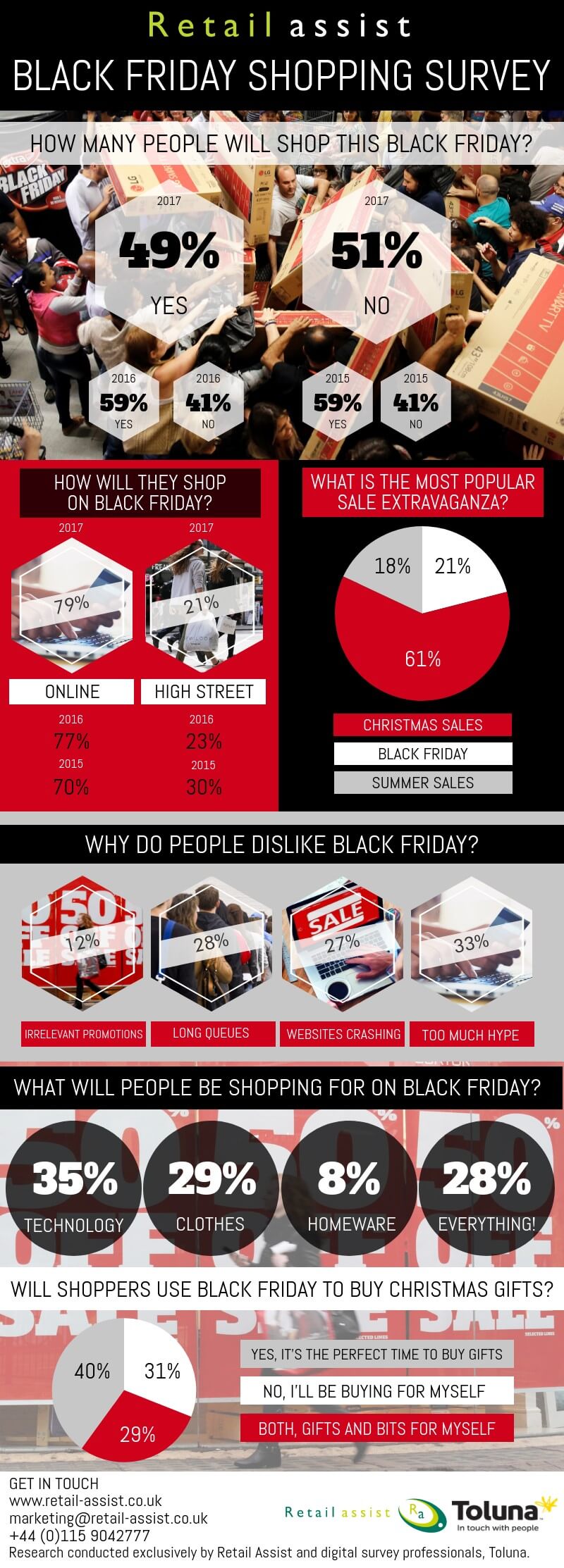This year, Black Friday 2017 falls on Friday 24th November. We expect the discounting event to continue over the weekend, with Cyber Monday on 27th November, and stretching over the rest of the week.
Last year, £1.23bn was spent online on Black Friday alone, making it the UK’s first billion pound shopping day. Spanning the whole week, from Monday 21st November to Monday 28th November in 2016, online sales rose to an estimated £6.5bn in the UK.
But how many people will shop on Black Friday this year, taking place in just 5 weeks’ time? The results may surprise you, as the “death of Black Friday” has begun to dominate the retail headlines, with retailers reluctant to participate in order to protect their margins.
As in previous years, check out our Black Friday 2017 research in our infographic below.
In order to analyse consumer sentiment towards Black Friday trading, this year 400 respondents took our Black Friday survey, powered by digital insights company Toluna.
See our full findings in the below Black Friday 2017 infographic. You can view our Black Friday 2016 survey results here.

For the first time ever, more consumers plan to avoid Black Friday this year than those who are planning to participate.
With just under half of respondents planning to buy something on Black Friday (49%), this is significantly lower than the same percentage as in 2016. Of course, this does not account for the impulse buyers that could take unexpected advantage of deals over the sale period.
However, many analysts have pointed towards the fact consumers have become accustomed to an ongoing discounting calendar throughout the year. Summer and autumn in particular have been stunted by mid-season sales. If sales and discounts are less of a “big deal”, and just part of the retail fabric, it’s understandable why the consumer mindset has shifted in the same way as Black Friday becomes “just another sale day”.
Another reason for the declining popularity of Black Friday can be understood from consumers’ strong disdain for Black Friday “hype” – over a third of respondents (33%) dislike Black Friday for this reason.
79% of respondents are set to be online Black Friday shoppers, which is a small increase on 77% in 2016. The shift to online in recent years can be tracked through our research displayed in the infographic. The majority of Black Friday spend in 2016 was via online channels, rising 12% year on year.
Ensuring that you have extra capacity in place is critical for omnichannel retailers and pureplay etailers alike, as a surge in website traffic can cause fatal outages for those who are unprepared. As well as completing special data capacity increase projects for peak trading, Retail Assist’s 24×7 operations monitoring and support is facilitating greater systems uptime, which is critical for any brand over Black Friday.
Long queues and websites crashing were two of the biggest negative factors recorded in our survey, so, how to avoid this on Black Friday 2017?
Till down-time and queueing are preventable issues, if you have the correct support in place. Our IT Help Desk analysts are experienced in front line retail, and understand the real impact of systems downtime at peak periods.
Can you afford to lose out on Black Friday sales? Increased demand means a busy store is inevitable, but making customer service more efficient should be a number one priority for retailers during peak trading season.
You can download our How To Guide: Preparing Stores for Peak Trading, here. Make sure to check out our Black Friday analysis blog, for a full breakdown of this year’s event.
If you’d like to use our survey results, please get in touch at marketing@retail-assist.co.uk. To receive a free high res download of our infographic, also email marketing@retail-assist.co.uk
We think you might like these posts too
© 2025 Retail Assist Limited. The Hub Floor 5A, 40 Friar Lane, Nottingham, NG1 6DQ.
Registered in England. Company number: 03790674
info@retail-assist.com | +44 (0)115 904 2777
Website Designed & Built by we are CODA